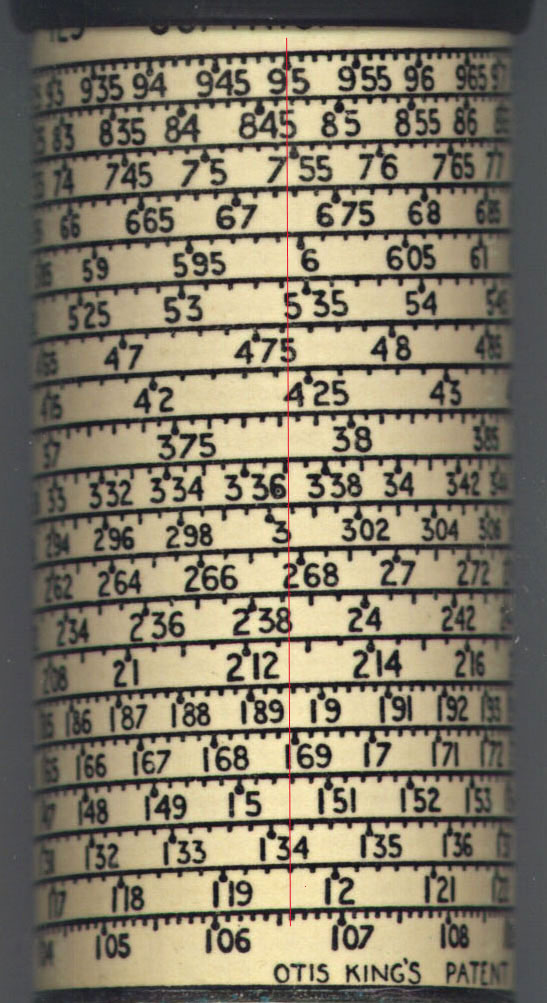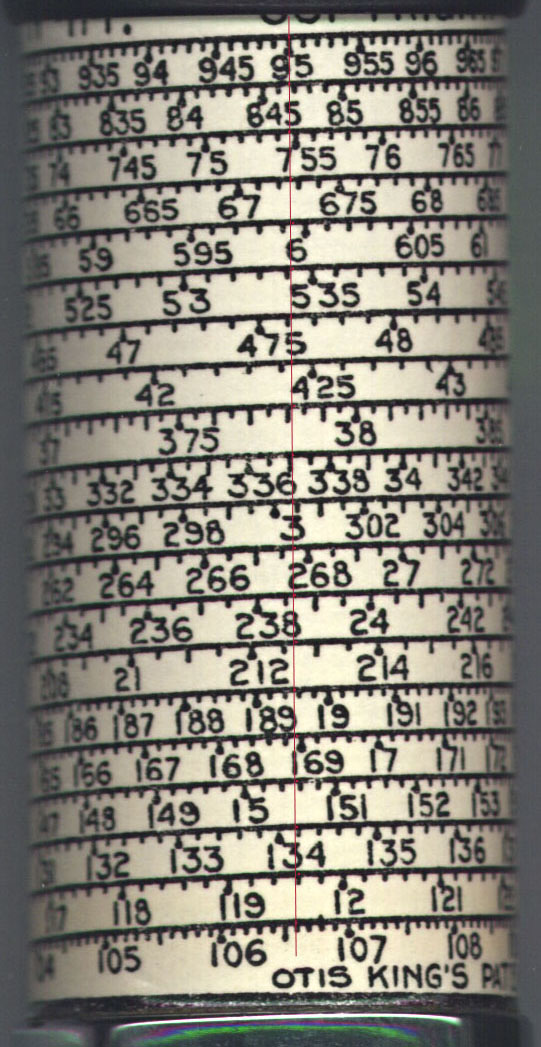 new file:
http://www.svpal.org/~dickel/OK/OKscales.html
new file:
http://www.svpal.org/~dickel/OK/OKscales.html
The high-resolution pictures down toward the bottom of the present page are also made on the scanner, as is the picture of Model K serial number R3474 at the left.
Scale #429 has the breakpoints moved a bit, to 1.13, 2.0, and 3.95. The early model K/L instructions say the break points are at 1.1, 2.0, and 4.0, which is incorrect for all scales we have seen.
These steps correspond to 0.09% to 0.25% of the value being read.
"My model N is less accurate because it covers a wider range. The upper scale (No. 424) goes from a mid-scale reading of 1 pound sterling to 1000 pounds sterling within 15 spirals, displaced along the axis of the rule by about 48 mm, compared with the upper scale of the model L, which only goes from 1 to 10, over 20 spirals, within a similar displacement of about 52 mm. The full upper scale of the model N is calibrated in pounds, shillings and pence units, from 1/4 penny to 1000 pounds. It includes just under 30 spirals, with a displacement of about 95 mm.
"Reading is also complicated by (i) the large number (15) of different divisions on the scale, (ii) the changes between decimal and non-decimal divisions, and (iii) the fact that the bottom scale uses different divisions. Starting at 1/4d (one farthing,1/4 penny), the top scale is divided by 64ths of a penny to 1d (one penny); then by 1/8d to 2/6 (two and a half shillings, 30 pence); then by farthings (1/4d) to 5 shillings (60d); by ha'pence (1/2d) to 10 shillings (120d); by pence to 1 pound (240d); by 2d to 2 pounds; by 3d to 3 pounds; by 6d to 6 pounds; by 1 shilling (12d) to 12 pounds; by 2s to 24 pounds; by 5s to 50 pounds; by 10s to 100 pounds; by 1 pound to 200 pounds; by 2 pounds to 400 pounds; and by 5 pounds to 1000 pounds.
"The lower scale (No.422) does not have monetary markings, but does have a number of gauge marks for conversion of metric and imperial weights and measures. The scale runs from 1/4 to 2500 in just under 20 spirals, with a displacement of about 64 mm. From 1/4 to 30 the tick marks are at 1/8 divisions (scale numbers are also by 1/8 to 5, by 1/4 to 10, by 1/2 to 20, and by whole numbers to 30); from 30 to 60 tick marks are by 1/4; to 125 by 1/2; to 250 by 1; to 500 by 2, to 1250 by 5; and to 2500 by 10.
"As you can imagine, these variations make it a real pain to set and read the rule!
"The gauge marks on the bottom scale 422 are designated by initial letters, a key to which is given around the bottom of the scale 'T=TON. CT=CWT .Q=QR. G=GROSS. M=MILE. K=KILOGM. MT=METRE. L=LITRE. A=ACRE.' The actual gauge marks, from the top of the scale down, are 1/2A, 1T, 1000K, 1M, 12G, 10G, 10CT, 500K, 6G, 5G, 4G, 5CT, 4CT, 3G, 3CT, 2G, 2CT, 100K, 1G, 1CT, 50K, 3Q, 2Q, 1MT, 1Q, 10K, 5K, 1K, and 1L. There is also a percent sign at the 100 point."
These Model N steps are up to about 0.8%, more than three times coarser than those of the Models K and L, in accordance with one-fourth as many wraps per decade (5 wraps per decade on model N versus 20 on models K and L).
The marked divisions are spaced from a minimum of 0.09% (0.001 at 1.12) to a maximum of 0.25% (0.01 at 4.0); so I'm suggesting you should be able to read to about 1/2 to 1/6 of the marked divisions.
Some calculations on the Otis King's model K have been noted to be in error by somewhat more than 0.04%, so we're interested in being able to show quantitatively what's going on with the scales. On this page, we make a start at it by looking at how accurately points align vertically, when calculated to have exactly a ratio of the 20th root of 10.
We find that the scales on the model L appear to be quite accurate,
but those on the model K are somewhat less accurate. See the pictures below.
Test them yourself by multiplying 1.066 times itself, and 1.196 times itself,
on both a model L and a model K. You'll get about 1.1364 and 1.1360 on L and
K for the first product (should be 1.136356, so the K has about 0.03% error),
and about 1.4305 and 1.431 on L and K for the second (should be 1.430416, so now
the K is about 0.03% off in the other direction). This level of error is
tolerable but measurable--I'm still looking for examples of worse errors,
which I have seen before.
This expression in Matlab: 9.5*((0.1).^((0:20)'/20)) returns a set of aligned scale points for the 20-wrap decade logarithmic scale, where the 9.5 is an arbitrary starting point at the top of the scale, 5% away from the ONE (about 5/12 of a turn).
First we look at a Scale 429 (lower scale on a model L). The calculated points line up within about a 1-pixel accuracy in this 480-pixel-per-inch image:

| |
| 9.5000 | |
| 8.4669 | |
| 7.5461 | |
| 6.7255 | |
| 5.9941 | |
| 5.3422 | |
| 4.7613 | |
| 4.2435 | |
| 3.7820 | |
| 3.3707 | |
| 3.0042 | |
| 2.6775 | |
| 2.3863 | |
| 2.1268 | |
| 1.8955 | |
| 1.6894 | |
| 1.5056 | |
| 1.3419 | |
| 1.1960 | |
| 1.0659 | |

| |
| 9.5000 | |
| 8.4669 | |
| 7.5461 | |
| 6.7255 | |
| 5.9941 | |
| 5.3422 | |
| 4.7613 | |
| 4.2435 | |
| 3.7820 | |
| 3.3707 | |
| 3.0042 | |
| 2.6775 | |
| 2.3863 | |
| 2.1268 | |
| 1.8955 | |
| 1.6894 | |
| 1.5056 | |
| 1.3419 | |
| 1.1960 | |
| 1.0659 | |